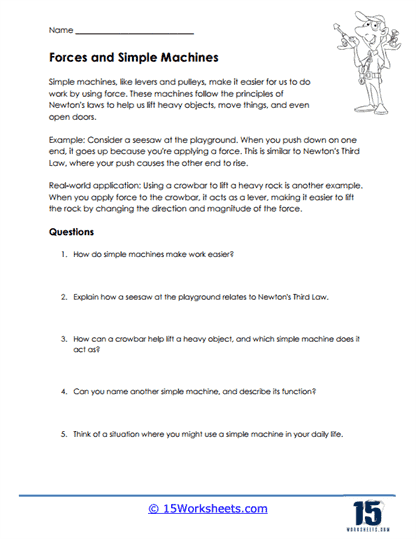Forces and Simple Machines

Worksheet Description
The worksheet examines the fundamental connection between basic physics principles, especially Newton’s laws, and the function of simple machines such as levers and pulleys. By highlighting scenarios like the operation of a seesaw or using a crowbar, the material illustrates how these everyday tools embody and exploit the principles of physics to aid in human tasks. These machines, as depicted in the content, essentially magnify or redirect forces, making tasks like lifting heavy objects or moving things more manageable. The provided examples serve as a bridge between abstract scientific concepts and tangible, everyday experiences.
To harness the benefits of simple machines, one must first understand the underlying physics, particularly Newton’s laws. Once these foundational concepts are clear, the next step is to identify how various machines like levers, pulleys, or inclined planes operate based on these laws. For instance, recognizing that pushing down on one end of a seesaw applies force which results in the other end lifting illustrates Newton’s Third Law in action. Similarly, understanding that a crowbar acts as a lever and can magnify applied force, making it easier to lift or shift objects, equips an individual to use these tools effectively.
The worksheet’s primary objective is to impart a deeper understanding of the role simple machines play in our daily lives and their rootedness in core physics principles. It encourages students to recognize that the seemingly complex laws of physics are not just theoretical but have real-world applications that simplify manual tasks. By drawing parallels between Newton’s laws and the operation of everyday tools, the worksheet demystifies the science behind these machines. Ultimately, the content strives to foster appreciation and comprehension of the natural synergy between physics and the machines that have been fundamental to human progress.
